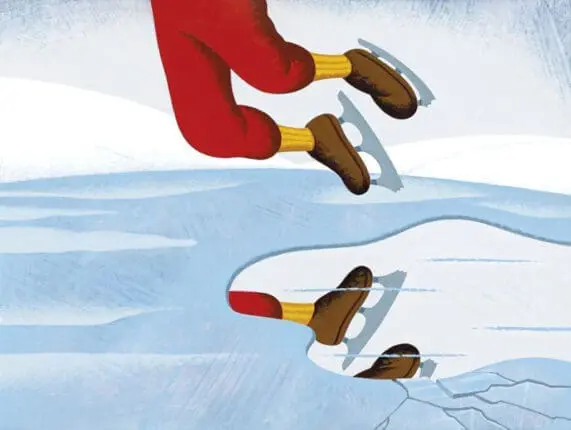When I was four years old, my family moved to Chatham, New Jersey, a small, maple-shaded town that I’ve never stopped thinking of as home. It had everything a kid needed: a drugstore with a soda fountain, miles of swampy woods to explore, a working dairy farm around the corner, and an ice-skating pond a block away. Later, it would become a shined-up suburb of New York, but in the 1950s the town stood on its own, radiating welcome and safety.
For the first few years, I watched from the sidelines. A shy kid, I was generally content to play with my big sister or consort with various imaginary animals. But around age eight, I emerged like a nervous debutante, brimming with pent-up sociability. In that postwar era, when parents were reproducing as though a contest were on, the numbers of children available to play with dazzled me. Right next door was Heidi, an impish girl my age, on whom nothing was lost. Further up the block were two sisters, diminutive and round-faced as munchkins. Down at the other end lived six freckle-faced kids, whose mother spoke with a thick, mesmerizing Irish accent. “Get out, the lot of ye!” she’d thunder when we lounged in her house too long. Diagonally across from us lived a craggy-faced, brooding boy, the undisputed captain of our block. He was three years my senior, and I had a mad, secret crush on him. Other, littler kids wandered and toddled after us everywhere.
By the time I was 10, we kids owned the street—or we thought we did. In warm weather, kickball was king. Nearly every evening of the summer, my sister, our two younger brothers, and I joined a dozen other children after supper to play in the middle of the street. Captains were named; teams were chosen. If we big kids were in a charitable mood, we’d allow the little ones to play. On one humid evening I watched my six-year-old brother, Bobby, execute a bumbling kick and run headlong to first base, pumping his skinny legs and arms for all they were worth. When he made it to base, his mile-wide grin melted something in me. I hadn’t known how badly he wanted to belong.
As dusk would deepen, we’d continue to play, screaming for our teammates to make their bases and talking trash to opponents when it was their turn to kick: “Easy out! Easy out!” Fireflies flashed in the air, while crickets clicked their summer songs. We inhaled the smells of newly mown grass and decaying roses on garden fences, never imagining that we were engaged in something fleeting and precious. There was only the thrilling whump of our feet making contact with the ball and watching it explode into the twilight as we sped around the bases to the hoarse shrieks of our teammates: “Go, go, go!”
Only when it became too dark to see the ball did we give up for the evening, trooping back home in twos or threes. Even if my team had lost, I was happy, floating on the sweat and camaraderie of the group. It’s hard now to separate the thrill of these intensely physical moments with the pleasure of engaging in these activities with other kids, kids as familiar to me as my own scabbed knees, and just as ready for the next crazy thing.
In the winters, sledding ruled. As soon as it snowed and the street became slick with ice, we burst out of our homes, bundled up like colorful marshmallows and dragging our Flexible Flyers behind us. Joanna Way was built on a hill, one that headed straight down to the town’s busiest thoroughfare, Lafayette Avenue. Our favorite game was to rocket down the street on our sleds and then make a violent swerve to the right at the last minute, avoiding Lafayette traffic by a foot or two. Sometimes we would “do a double,” which meant making this particular maneuver with a younger sibling piled on top of an older one. This was our version of looking after the little kids, and it was exactly as perilous as it sounds. Somehow, we escaped serious injury—as far as I remember, anyway.
Where were the parents? We never really thought about it, beyond being glad that they were elsewhere. Back then, kids were supposed to be out of the house and out of grownups’ hair as much as possible. People often say about this era, “It was different then; neighborhoods were safer.” This may be true in the sense of less “stranger danger,” but left to ourselves, we flirted regularly with the dark side. Our brains were still in a beta stage of development, with wires dangling loose and vital connections yet unmade. To this day I remember what it felt like—a glorious appetite for risk paired with the conviction of imperishability.
Nowhere did this combination play out more vividly than on the ice-skating pond. Almost directly behind the woods of our house lay an oval of water sheltered by elm and maple trees and lined with skunk cabbages. It was known as Feehan’s Pond, in deference to the family who owned the property. As soon as the first freeze took hold of North Jersey, Mr. and Mrs. Feehan allowed neighbor kids to skate on their pond unsupervised. “Goin’ to Feehan’s!” I’d shout to my mother on frigid weekend mornings, and then I’d cut through our back woods, perch on a big rock to lace up my skates, and glide out onto glassy paradise.
Often, a couple dozen kids were already on the ice, and given the dimensions of the pond—maybe 35 by 20 feet—we did a pretty amazing job of not smacking into each other. Instead, we executed a kind of loosely choreographed dance known only to us, lazily looping around each other and then turning on a dime to do a backward glide, casually looking over our shoulders to avoid a collision. From time to time, one of us older kids would zoom down the pond’s length at full speed, only to turn sharply on the tips of our skates and stop short at the mouth of a good-sized hole at the pond’s far edge, a gash of black water that never iced over. We had enough sense to skip such stunts whenever grownups came around. Now and then, some of the more agile parents would walk down through the woods to skate with us, sometimes bringing thermoses of hot chocolate. My own parents showed up a couple of times, and I remember being pleased to see them, proud and a little surprised that they could actually skate. I especially liked watching my mother, not just because she was light on her feet, but also because as she whirled around the pond, her cheeks pink with cold, she wore a buoyant, girlish smile that I didn’t see often enough. It reminded me of a photo I’d found of her at about age 14, standing up at bat in a neighborhood baseball game. She looked loose and confident, and just a little bit badass.
Back on the skating pond, we’d wait for the grownups to head home so we could resume our feats of daring. When I was about 12 and had executed the fast-stop-at-the-brink maybe a hundred times, I itched to try something new. So one afternoon, with a gaggle of kids egging me on, I made a headlong charge down the length of the pond toward the watery hole until I heard the first crack of ice under my feet. At that exact moment, I made a flying jump over the hole onto dry land. Even now, I can call back the specific magic of that moment: the wind stinging my face, the heart-stopping splintering of ice, my soaring leap to safety, and the cheer that went up in its wake.
Five decades later, on a cold February day, I emerge from my car and plant my feet on the pavement. I watch myself step carefully across the icy blacktop toward the Acme, assisted by a pair of Ugg boots with extra tread. It makes me laugh—sort of. Every day, another act of caution. “Ring the bells that still can ring,” urged Leonard Cohen, and I’m game. I’ve recently dipped a toe into public storytelling, which is as scary and thrilling as anything I’ve done in years. I still dance to “Blinded by the Light” at parties, if I’m willing to put up with sore knees for the next few days. Usually, I am.
Still, the 12-year-old kid in me bangs on the wall. I miss her, that reckless, go-for-broke girl who leapt across thin ice, literally, certain that the universe would catch her and escort her to safety. She was lucky, for sure. But only the grown-up in me knows this. The kid is wild with joy.
None of us knew, back then, that we’d get older. If you’d tried to tell us, we’d have scoffed. We were just kids together, forever young, bonded by the helter-skelter of group motion. We were as loud and kinetic and heedless as we could get away with, and we got away with plenty. I can still feel the shimmer of it.
Illustration © Adam Niklewicz
Marian Sandmaier
Marian Sandmaier is the author of two nonfiction books, Original Kin: The Search for Connection Among Adult Sisters and Brothers (Dutton-Penguin) and The Invisible Alcoholics: Women and Alcohol Abuse in America (McGraw-Hill). She is Features Editor at Psychotherapy Networker and has written for the New York Times Book Review, the Washington Post, and other publications. Sandmaier has discussed her work on the Oprah Winfrey Show, the Today Show, and NPR’s “All Things Considered” and “Fresh Air.” On several occasions, she has received recognition from the American Society of Journalists and Authors for magazine articles on psychology and behavior. Most recently, she won the ASJA first-person essay award for her article “Hanging Out with Dick Van Dyke” on her inconvenient attack of shyness while interviewing. You can learn more about her work at www.mariansandmaier.net.













